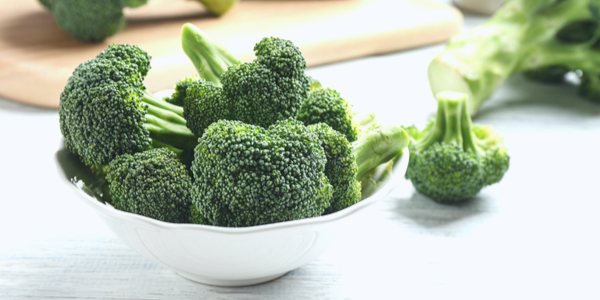
The look, taste, and smell of broccoli are unique compared to other vegetables and can be polarizing for approval.
As part of the cruciferous vegetable family, some of the health benefits of broccoli are similar to cauliflower, kale, Brussels sprouts, arugula, etc. However, there are broccoli health benefits that warrant special attention and effort for adding it to your meals and snacks.
Curious what makes broccoli so special? Take a deep dive into all things broccoli-related including nutrition information, unique health benefits, and easy ways to add broccoli to your meals.
Broccoli Nutrition Facts
Broccoli is low in calories and while being a good source of vitamins, minerals, antioxidants, and fiber arguably making it one of the healthiest fruits and vegetables by many health experts.
As seen below, there are only six grams of carbs in broccoli per serving while providing 2.4 grams of fiber making it a great choice for lower carbohydrate diets.
Broccoli nutrition (per one cup serving):
Nutrient Amount
Percent Daily Value
Calories
31
Fat
0 grams (g)
0%
Sodium
30 milligrams (mg)
1%
Carbohydrates
6 g
2%
Fiber
2.4 g
9%
Sugar
1.6 g
N/A
Protein
2.6 g
5%
Calcium
43 mg
3%
Iron
0.7 mg
4%
Potassium
288 mg
6%
Vitamin C
81.2 mg
90%
Vitamin K
92.5 micrograms (mcg)
77%
In addition to these nutrients, a cup of broccoli provides between three and 14 percent DV of B vitamins (except B12), vitamin A, vitamin E, copper, magnesium, manganese, phosphorus, selenium, and zinc.
5 Broccoli Health Benefits
In addition to being a good source of antioxidants, vitamins, minerals, and fiber, broccoli, like all cruciferous vegetables, has unique sulfur compounds called glucosinolates that provide special health benefits.
If taste alone is not enough reason for you to add more broccoli, these research-backed health benefits of broccoli may help encourage eating more of this mighty green vegetable.
1. May Fight Against Cancer
According to the American Institute for Cancer Research, people who eat more vegetables and fruits have a lower risk of a wide range of cancers. Cruciferous vegetables like broccoli in particular have also been shown to have unique potential for lowering cancer risks.
The National Cancer Institute suggests when the glucosinolates from broccoli are broken down in the body, they have been shown to help fight cancer by:
• Inactivating carcinogens
• Inhibiting blood vessels forming in cancer cells
• Protecting cells from DNA damage, which can be the first step of cancer cells forming
Research is ongoing for broccoli specifically lowering cancer risk, as human studies have shown mixed results. Some, but not all, studies have shown broccoli may help protect against prostate, breast, or colon cancer.
2. May Offer Eye Protection
Carrots may be good for your eyes but, surprise, so is broccoli. Broccoli has the same antioxidants in carrots, lutein and zeaxanthin, that are associated with protecting eye health.
These antioxidants can specifically protect eye cells from damage and can help lower the risk of macular degeneration associated with aging.
3. Could Lower the Risk of Type 2 Diabetes
The sulforaphane compound in broccoli (and other cruciferous vegetables) may be a promising new way to help people turn "off" genes associated with type 2 diabetes, according to a 2017 LiveScience article.
Subjects with type 2 diabetes were given broccoli sprout extract for 12 weeks, and after the 12 weeks obese subjects had lower blood glucose levels compared to the start of the study. More research is needed for broccoli's impact on diabetes risk, as the amount eaten in this study was 100 times the sulforaphane content compared to a regular broccoli serving.
Even though more research is needed, other human and animal studies have shown broccoli can favorably impact blood sugar levels.
4. May Benefit Heart Health
Broccoli can benefit heart health in many ways! First, broccoli is a source of soluble fiber. Soluble fiber helps lower blood cholesterol levels.
Second, broccoli's abundance of antioxidants can protect blood vessels from getting damaged. Next, the potassium, magnesium and B vitamins all help maintain healthy blood pressure levels and lower the risk of heart disease.
5. Could Aid in Digestion
Broccoli's high fiber content is not only good for heart health, as the fiber from broccoli can also benefit digestion. Eating high-fiber foods, like broccoli, can help keep bowel movements regular. The fiber from broccoli can also act as fuel for beneficial probiotics in the colon.
Sulforaphane from broccoli has digestive health benefits as well; this compound can help fight off the bacteriaHelicobacter pylori. If there is too much of this bacteria in the stomach, an ulcer can be more likely to develop.
6 Classic & Unique Ways to Use Broccoli (Besides Steaming)
Broccoli can simply be served raw, steamed, or boiled. However, if you are bored of these easy preparation techniques or looking for new ways to serve up broccoli, try these classic and different ways to enjoy broccoli!
1. Give Broccoli a Roast
Steaming broccoli can be the easiest default for cooking broccoli, but another just as easy- and arguably more delicious- way to cook broccoli is to roast it in the oven. Broccoli can be roasted with olive oil and just salt and pepper, or choose to add your favorite seasonings for more flavor.
What goes with roasted broccoli? Pairing it with beef stroganoff as a tasty but low-calorie and low-carb side dish!
2. Bulk Up Dishes
Broccoli can easily be added to many dishes to bulk up the volume and veggie amount in a meal. For example, broccoli can be added to pasta dishes, soups, scrambled eggs, omelets, or added to vegetable fried rice and stir-fries.
Add fresh or frozen broccoli to the saute pan with other ingredients or for the last few minutes of simmering like soups and pasta noodles as an easy way to bulk up the volume of a dish without bulking the calories.
3. Use as Green "Sprinkles"
Use broccoli for sprinkles? That is what dietitian Kacie Barnes from Mama Knows Nutrition suggests for kids (and maybe adults who are broccoli hesitant)!
Lightly cut off the very tips of broccoli so you get sprinkle-length broccoli pieces. Then add the "sprinkles" to snacks and meal times. She suggests letting kids decide what dish the sprinkles get added to - the options are endless!
4. Repurpose the Stems for Broccoli Chips
Don't throw out the broccoli stems! Broccoli florets usually get highlighted as the main part to eat for broccoli, but the stems of broccoli can be creatively eaten as broccoli chips.
Broccoli stems and carrots can be peeled, thinly sliced, tossed with olive oil and spices, and roasted in the oven for about 30 to 40 minutes.
5. Transform Broccoli Into Fritters
Transform steamed broccoli into something flavorful and crunchy by making broccoli fritters. Broccoli fritters can be made with steamed broccoli that is mashed and dredged in a batter of garlic, flour, grated parmesan, egg, milk, salt, and pepper.
Pair with a simple yogurt sauce of plain yogurt, lemon juice, salt, and pepper.
6. Use as a Dipper
Broccoli chips, fresh, steamed, or roasted broccoli can all be used as dippers for sauces in place of traditional chips or crackers. Broccoli can pair especially well with healthy dips that are based on yogurt, cheese, or hummus.
Broccoli Health Benefits In Summary
Broccoli is a member of the cruciferous vegetable family that has unique components that have been shown to provide unique health benefits. Broccoli may help lower the risk for certain cancers and type 2 diabetes, and provide heart, eye, and digestive health benefits.
Broccoli is low in calories and carbohydrates and a good source of many antioxidants, vitamins, minerals, and antioxidants.
Steaming and eating broccoli fresh tends to be the most common ways to eat broccoli, but there are many more tasty ways to enjoy it. Broccoli can be roasted, added to many different savory dishes, made into "sprinkles," chips, fritters, and used as chip alternatives for dips.
References:
Axelsson AS, Tubbs E, et al. Sulforaphane reduces hepatic glucose production and improves glucose control in patients with type 2 diabetes. Science Translational Medicine. Published June 14, 2017. https://www.science.org/doi/abs/10.1126/scitranslmed.aah4477.
Broccoli and cruciferous vegetables: Reduce overall cancer risk. American Institute for Cancer Research. Published August 2, 2021. https://www.aicr.org/cancer-prevention/food-facts/broccoli-cruciferous-vegetables/.
Broccoli, raw. Broccoli, raw nutrition facts and analysis. https://www.nutritionvalue.org/Broccoli%2C_raw_nutritional_value.html?size=1%2Bcup%2Bchopped%2B%3D%2B91%2Bg.
Cruciferous vegetables and cancer prevention. National Cancer Institute. https://www.cancer.gov/about-cancer/causes-prevention/risk/diet/cruciferous-vegetables-fact-sheet.
Szalay J. Broccoli: Health benefits, Risks & Nutrition facts. LiveScience. Published June 15, 2017. https://www.livescience.com/45408-broccoli-nutrition.html.







